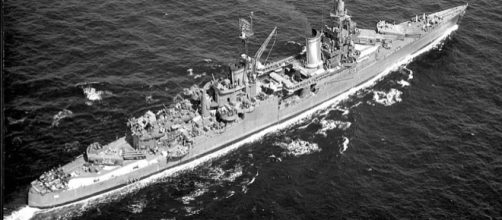Paul Allen, co-founder of Microsoft, has finally located the wreckage of USS Indianapolis, a Navy cruiser that was torpedoed in 1945 in the last phase of World War Ii. It is labeled as one of the worst disasters in U.S. naval history and the wreckage is lying on the bed of the Pacific nearly 3.5 miles below the surface. Its anchor and bell are clearly visible.
World War II and the atom bomb that was dropped on Hiroshima are interlinked and also have links to USS Indianapolis because it was on a secret mission to deliver materials for the atomic bomb.
The cruiser was torpedoed by Japan as it was returning after completing its mission and sank in the Pacific Ocean.
History of USS Indianapolis
Los Angeles Times reports that in July 1945, USS Indianapolis was on a secret mission to deliver materials to make the atomic bomb that was scheduled to be dropped on Hiroshima. No one knew at the time that it was the last phase of World War II. A Japanese submarine torpedoed Indianapolis and it sank within a few minutes before it could transmit any distress signal.
There were around 1,200 crew members on board and 800 survived but were at the mercy of the elements. It was shark-infested waters and finally, only 316 were rescued. The rest died from exposure, dehydration, drowning, and sharks.
The commanding officer of the ship was Navy Capt. Charles B. McVay III and he was convicted of negligence because he had not given orders to the cruiser to travel in a zigzag pattern as is done in such circumstance. He was court-martialed on Dec. 19, 1945, and committed suicide with his service revolver in 1968. However, some of the survivors got together to clear his name and succeeded in doing so when, in 2000, he was posthumously exonerated by President Clinton.
The task ahead for Paul Allen
Paul Allen wants to reconstruct the past and hopes to go deep into this chapter pertaining to the history of World War II. He wants to honor the brave men of the USS Indianapolis and their families because this ship played a major role to bring the war to an end. Hiroshima was bombed first and then Nagasaki and Japan announced its surrender.
Allen’s team got help from the work of Navy historian Richard Hulver who was conducting research in his own way. In the course of his work, he chanced upon a clue through a blog that provided an indication of the probable location of where the ship had sunk.
Allen used that information to zero in on the exact place. In order to carry out his research, he had purchased a vessel and retrofitted it with equipment capable of diving 3.5 miles below the ocean’s surface where the wreckage lay for 72 years. It is now a case of collecting the bits and pieces to reconstruct the past. It has all the ingredients necessary for a potboiler and could make a block buster movie. “Dunkirk”, a recently released World War II movie, is doing well. A movie about the USS Indianapolis can also be expected to draw the crowds.


